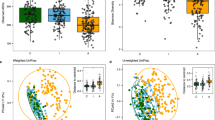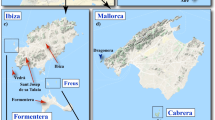Abstract
Studies of laboratory animals demonstrate extensive variation of host gut microbiomes and their functional capabilities across populations, but how does anthropogenic change impact the microbiomes of non-model species? The anthropogenic movement of species to novel environments can drastically alter animals’ microbiomes; however, factors that shape invasive species gut microbiota during introduction remain relatively unexplored. Through 16S amplicon sequencing on guttural toad (Sclerophrys gutturalis) faecal samples, we determine that residence time does not impact microbiome variation between source and introduced populations. The youngest population (~ 20 years in Cape Town) has the most distinct microbiome and associated functional capabilities, whereas longer residence times (~ 100 years in Réunion and Mauritius) produce less divergent microbial compositional, phylogenetic, and predicted functional diversity and differential abundance from source populations (Durban). Additionally, we show extensive variation of microbial and functional diversity, as well as differential abundance patterns in an expanding introduced population (Cape Town) between core and periphery sites. Contrasting previous studies, we suggest that introduction pathways might be an important factor impacting host microbial divergence. These findings also imply that the microbiome can diverge in accordance with host population dynamics.







Similar content being viewed by others
Availability of Data and Material
Raw sequence data will be available in the NCBI Sequence Read Archive (accession number: PRJNA774346).
References
Sommer F, Bäckhed F (2013) The gut microbiota – masters of host development and physiology. Nat Rev 11:227–238. https://doi.org/10.1038/nrmicro2974
McKenney EA, Koelle K, Dunn RR et al (2018) The ecosystem services of animal microbiomes. Mol Ecol 27:2164–2172. https://doi.org/10.1111/mec.14532
Trevelline BK, Fontaine SS, Hartup BK et al (2019) Conservation biology needs a microbial renaissance: a call for the consideration of host-associated microbiota in wildlife management practices. Proc R Soc B 286:20182448. https://doi.org/10.1098/rspb.2018.2448
Hauffe HC, Barelli C (2019) Conserve the germs: the gut microbiota and adaptive potential. Conserv Genet 20:19–27. https://doi.org/10.1007/s10592-019-01150-y
Bahrndorff S, Alemu T, Alemneh T et al (2016) 2016 The microbiome of animals: implications for conservation biology. Int J Genomics 2016:5304028. https://doi.org/10.1155/2016/5304028
Colautti RL, Ricciardi A, Grigorovich IA et al (2004) Is invasion success explained by the enemy release hypothesis? Ecol Lett 7:721–733. https://doi.org/10.1111/j.1461-0248.2004.00616.x
MacLeod CJ, Paterson AM, Tompkins DM et al (2010) Parasites lost – do invaders miss the boat or drown on arrival? Ecol Lett 13:516–527. https://doi.org/10.1111/j.1461-0248.2010.01446.x
Blackburn TM, Ewen JG (2016) Parasites as drivers and passengers of human-mediated biological invasions. EcoHealth 14:61–73. https://doi.org/10.1007/s10393-015-1092-6
Amsellem L, Brouat C, Duron O et al (2016) Importance of microorganisms to macroorganisms invasions: is the essential invisible to the eye? Adv Ecol Res 57:99–146. https://doi.org/10.1016/bs.aecr.2016.10.005
Coats VC, Rumpho ME (2014) The rhizosphere microbiota of plant invaders: an overview of recent advances in the microbiomics of invasive plants. Front Microbiol 5:368. https://doi.org/10.3389/fmicb.2014.00368
Yoshida T, Goka K, Ishihama F et al (2007) Biological invasion as a natural experiment of the evolutionary processes: introduction of the special feature. Ecol Res 22:849–854. https://doi.org/10.1007/s11284-007-0435-3
Lau JA, Suwa T (2016) The changing nature of plant-microbe interactions during a biological invasion. Biol Invasions 18:3527–3534. https://doi.org/10.1007/s10530-016-1245-8
Sexton JP, McIntyre PJ, Angert AL et al (2009) Evolution and ecology of species range limits. Annu Rev Ecol Evol Sci 2009(40):415–436. https://doi.org/10.1146/annurev.ecolsys.110308.120317
Eckert CG, Samis KE, Lougheed SC (2008) Genetic variation across species’ geographical ranges: the central-marginal hypothesis and beyond. Mol Ecol 17:1170–1188. https://doi.org/10.1111/j.1365-294X.2007.03659.x
Santos B, Bletz MC, Sabino-Pinto J et al (2021) Characterization of the microbiome of the invasion Asian toad in Madagascar across the expansion range and comparison with a native co-occurring species. PeerJ 9:e11532. https://doi.org/10.7717/peerj.11532
Telford NS, Channing A, Measey J (2019) Origin of invasive populations of the Guttural toad (Sclerophrys gutturalis) on Réunion and Mauritius Islands in Constantia South Africa. Herpetol Conserv Biol 14:380–392
Vimercati G, Hui C, Davies SJ et al (2017) Integrating age structured and landscape resistance models to disentangle invasion dynamics of a pond-breeding anuran. Ecol Model 356:104–116. https://doi.org/10.1016/j.ecolmodel.2017.03.017
Du Preez LH, Weldon C, Cunningham MJ, Bufogutturalis Power, et al (1927). In: Minter LR, Burger M, Harrison JA et al (eds) Atlas and Red Data Book of the Frogs of South Africa, Lesotho and Swaziland. Minter Smithsonian Institution, Washington, p 2004
Baxter-Gilbert JH, Florens FB, Baider C et al (2021) Toad-kill: prey diversity and preference of invasive guttural toads (Sclerophrys gutturalis) in Mauritius. Afr J Ecol. https://doi.org/10.1111/aje.12814
Cheke A, Hulme J (2008) Lost land of the Dodo – an ecological history of Mauritius, Réunion and Rodrigues. T & Ad Poyser, London
de Villiers A (2006) Amphibia: Anura: Bufonidae Bufo gutturalis Power, 1927. Guttural toad. Introduced population. African Herp News 40:28–29
Davies SJ, Bell JA, Impson D et al (2020) Coordinating invasive alien species management in a biodiversity hotspot: the CAPE Invasive Alien Animals Working Group. Bothalia 50:1. https://doi.org/10.38201/btha.abc.v50.i1.10
Baxter-Gilbert J, Riley JL, Wagener C et al (2020) Shrinking before our isles: the rapid expression of insular dwarfism in two invasive populations of guttural toad (Sclerophrys gutturalis). Biol Lett 16:20200651. https://doi.org/10.1098/rsbl.2020.0651
Klindworth A, Pruesse E, Schweer T et al (2012) Evaluation of general 16S ribosomal RNA gene PCR primers for classical and next-generation sequencing-based diversity studies. Nucleic Acids Res 41:e1. https://doi.org/10.1093/nar/gks808
Bolyen E, Rideout JR, Dillon MR et al (2019) Reproducible, interactive, scalable and extensible microbiome data science using QIIME 2. Nat Biotechnol 37:852–857. https://doi.org/10.1038/s41587-019-0209-9
Callahan BJ, McMurdie PJ, Rosen MJ et al (2016) DADA2: high resolution sample inference from Illumina amplicon data. Nat Methods 13:581–583. https://doi.org/10.1038/nmeth.3869
Katoh K, Standley DM (2013) MAFFT Multiple Sequence Alignment Software Version 7: improvements in performance and usability. Mol Biol Evol 30:772–780. https://doi.org/10.1093/molbev/mst010
Lane DJ, Stackebrandt E, Goodfellow M (1991) 16S/23S rRNA Sequencing. Nucleic acids techniques in bacterial systematics. Wiley, New York
Price MN, Dehal PS, Arkin AP (2010) FastTree 2 - approximately maximum-likelihood trees for large alignments. PLoS ONE 5:e9490. https://doi.org/10.1371/journal.pone.0009490
Quast C, Pruesse E, Yilmaz P et al (2013) The SILVA ribosomal RNA gene database project: improved data processing and web-based tools. Nucleic Acids Res 41:D590-596. https://doi.org/10.1093/nar/gks1219
Douglas GM, Maffei VJ, Zaneveld JR et al (2020) PICRUSt2 for prediction of metagenome functions. Nat Biotechnol 38:685–688. https://doi.org/10.1038/s41587-020-0548-6
Vimercati G, Davies SJ, Measey J (2019) Invasive toads adopt marked capital breeding when introduced to a cooler, more seasonal environment. Biol J Linn Soc 128:657–671. https://doi.org/10.1093/biolinnean/blz119
R Core Team (2019) R: a language and environment for statistical computing. R Foundation for Statistical Computing, Vienna
Bisanz JE (2018) qiime2R: importing QIIME2 artifacts and associated data into R sessions
McMurdie PJ, Holmes S (2013) phyloseq: an R package for reproducible interactive analysis and graphics of microbiome census data. PLoS ONE 8:e61217. https://doi.org/10.1371/journal.pone.0061217
Shetty SA, Lahti L (2018) Microbiomeutilities: an R package for utilities to guide in-depth marker gene amplicon data analysis
Oksanen J, Blanchet FG, Friendly M et al (2007) vegan: Community ecology package
Zuur AF, Leno EN, Elphick CS (2010) A protocol for data exploration to avoid common statistical problems. Methods Ecol Evol 1:3–14. https://doi.org/10.1111/j.2041-210X.2009.00001.x
Barton K (2009) MuMIn – multi-model inference
Nakagawa S, Schielzeth H (2013) A general and simple method for obtaining R2 from generalized linear mixed-effects models. Methods Ecol Evol 4:133–142. https://doi.org/10.1111/j.2041-210x.2012.00261.x
Gloor GB, Macklaim JM, Pawlowsky-Glahn V et al (2017) Microbiome datasets are compositional: and this is not optional. Front Microbiol 8:2224. https://doi.org/10.3389/fmicb.2017.02224
Silverman JD, Washburne AD, Mukherjee S et al (2017) A phylogenetic transform enhances analysis of compositional microbiota data. eLife 6:21887. https://doi.org/10.7554/eLife.21887
Love MI, Huber W, Anders S (2014) Moderated estimation of fold change and dispersion for RNA-seq data with DESeq2. Genome Biol 15:550. https://doi.org/10.1186/s13059-014-0550-8
Mitchell CE, Blumenthal D, Vojtěch J et al (2010) Controls on pathogen species richness in plants’ introduced and native ranges: roles of residence time, range size and host traits. Ecol Lett 13:1252–1535. https://doi.org/10.1111/j.1461-0248.2010.01543.x
Kohl KD, Cary TL, Karasov WH et al (2013) Restructuring of the amphibian gut microbiota through metamorphosis. Environ Microbiol Rep 5:899–903. https://doi.org/10.1111/1758-2229.12092
Couch CE, Arnold HK, Crowhurst RS et al (2020) Bighorn sheep gut microbiomes associate with genetic spatial structure across a metapopulation. Sci Rep 10:6582. https://doi.org/10.1038/s41598-020-63401-0
Phillips CD, Phelan G, Dowd SE et al (2012) Microbiome analysis among bats describes influences of host phylogeny, life history, physiology and geography. Mol Ecol 12:2617–2627. https://doi.org/10.1111/j.1365-294X.2012.05568.x
Louca S, Polz MF, Mazel F, Albright MBN et al (2018) Function and functional redundancy in microbial systems. Nat Ecol Evol 2:936–943
Muegge BD, Kuczynski J, Knights D et al (2011) Diet drives convergence in gut microbiome functions across mammalian phylogeny and within humans. Science 322:970–974. https://doi.org/10.1126/science.1198719
Youngblut ND, Reischer GH, Walters W, Schuster N, Walzer C, Stalder G, Ley RE, Farnleitner AH (2019) Host diet and evolutionary history explain different aspects of gut microbiome diversity among vertebrate clades. Nat Comm 10:2200. https://doi.org/10.1038/s41467-019-10191-3
Acknowledgements
CW and JM would like to thank Christy Momberg, Erika Nortje, and Suzaan Kritzinger-Klopper for logistical and administrator support. CW and JM thank James Baxter-Gilbert, Julia Riley, Carla Madelaire, Adriana Barsotti, Cláudia Baider, Vincent Florens, Sohan Sauroy-Toucouére, Dominique Strasberg, Damian van Aswegen, and Nitya Mohanty for assistance with field work. Additionally, CW thanks James Baxter-Gilbert and Jan-Hendrik Keet for fruitful discussions during the early stages of this study. CW also thanks Black River Gorges National Park, the Durban Botanical Gardens, and the communities of Notre Dame, Villèle, Pont Payet, and Queensburgh for help collecting toads. CW and JM are grateful to the NCC group for collecting faecal samples in Cape Town. In particular, we would like to thank Jonathan Bell, Lulama Zibi, and Nabeelah Domingo. The Central Analytical Facilities at Stellenbosch University processed and sequenced faecal samples. CW and JM are especially thankful to Alvera and Carel for facilitating the sequencing of samples.
Funding
This study was supported by funding from the DSI-NRF Centre of Excellence for Invasion Biology (CIB) awarded to CW and JM.
Author information
Authors and Affiliations
Contributions
CW and JM designed the study. CW and JM collected the samples. CW and MDP performed the bioinformatics. CW performed the formal data analyses. CW wrote the manuscript and JM contributed to revisions. All authors have seen and approved the manuscript.
Corresponding author
Ethics declarations
Ethics Approval
Ethical clearance for research was obtained from Stellenbosch University Animal Ethics Committee (Protocol Number ACU-2019–9533). Collections in Cape Town occurred as part of an ongoing eradication programme of Sclerophrys gutturalis to mitigate impacts on the threatened endemic, the western leopard toad Sclerophrys pantherina (Davies et al. 2020), and in Durban and Mauritius under the permission from KZN wildlife (OP 4353/2018) and the Mauritian National Parks and Conservation Services (NP 46/3 V3), respectively.
Conflict of Interest
The authors declare no competing interests.
Supplementary Information
Below is the link to the electronic supplementary material.
Rights and permissions
About this article
Cite this article
Wagener, C., du Plessis, M. & Measey, J. Invasive Amphibian Gut Microbiota and Functions Shift Differentially in an Expanding Population but Remain Conserved Across Established Populations. Microb Ecol 84, 1042–1054 (2022). https://doi.org/10.1007/s00248-021-01896-4
Received:
Accepted:
Published:
Issue Date:
DOI: https://doi.org/10.1007/s00248-021-01896-4




